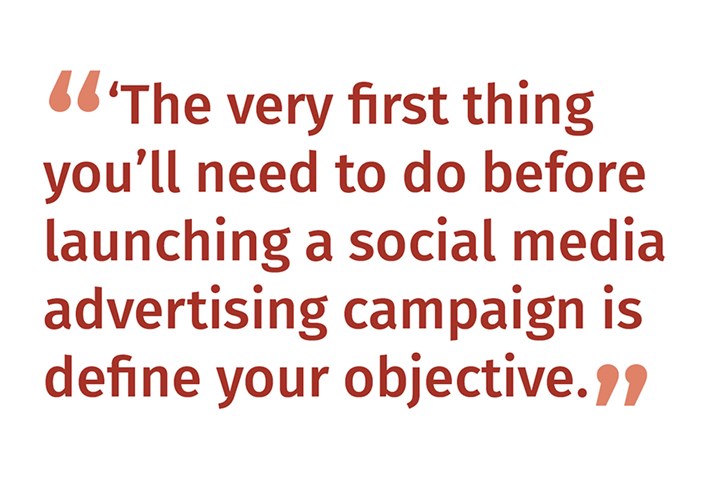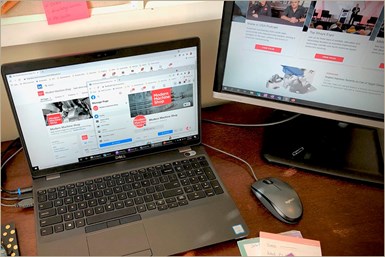3 Things to Know Before Launching a Social Media Ad Campaign
This article provides a starting point for the new social media advertiser looking to make an impression on the manufacturing industry buyer. The author will cover the importance of defining a campaign objective, the basics of building an audience, and the best practices for crafting your message.
#brandbuilding
Social media may be more known for friends, food and fun, but there’s also a place on social media for new technologies and advanced manufacturing. Your manufacturing customers are on social media. Although they may not be actively looking for your product as they scroll through their feed, your brand can still make an impact.
If you have a new product to announce, tips and guides to share, an event to promote, or content to spread, social media can be a beneficial channel for reaching the manufacturing industry buyer.
This article provides a starting point for the new social media advertiser. I’ll cover the importance of defining a campaign objective, the basics of building an audience, and the best practices for crafting your message.

1. Define your objective
The very first thing you’ll need to do before launching a social media advertising campaign is define your objective. Why are you running the campaign? What do you hope to gain from your ads?
Some common objectives:
- Drive traffic to a website
- Collect leads from a whitepaper download
- Generate awareness from video views
- Encourage engagement with a social media page
Setting your objective is not only a recommendation, it’s a requirement. The first question LinkedIn, Facebook, and Twitter ad platforms ask is ‘what’s the campaign objective.’ The rest of your campaign will be built according to the objective you select, from your audience to your message to your means of measuring success.
In fact, your objective may even determine where you choose to advertise in the first place. Depending on your budget, you may decide to advertise on one or multiple platforms. I have found Facebook to be best at driving website visitors. LinkedIn to be most likely to deliver qualified leads. And Twitter is best when there is an existing event, product, or industry association to build an audience from.
2. Identify your audience
Once you’ve defined your campaign objective you’ll need to identify your target audience, or your ideal customer. Think of your existing customers and list out some of their individual and business characteristics.
Audience characteristics to consider:
- Location
- Age, job experience, seniority
- Job Function, title, or professional skills
- Industry, company size
These characteristics will be used to build your target audience on each social media platform. Typically, a LinkedIn audience will be built from professional skills and experience. A Facebook audience will be defined by demographics and interests. And a Twitter audience is best built through relation to competitors, events, industry associations, and hashtags.
The examples listed here are not exclusive and the options for audience building on each platform are extensive. Take your time on this step and experiment with the size of audience you can build using different parameters and keywords. A good practice is to use 2-3 parameters when building your audience.
3. Craft your message
Social media feeds move fast. To capture the attention of your target audience, an advertisement needs to have a clear, concise message and a strong visual.
- Know your audience. Your message may vary depending on who you’re trying to reach. Consider the information your target audience may be looking for. A CNC Machinist may be interested in the features of a tool or a guide for using the tool, while a Shop Owner may be interested in how this new tool can lead to time and cost savings.
- Be brief. With technical topics it can be difficult to keep words short. Instead of getting lost in detail, address one key point and use a strong call to action to entice the reader to click through for more. For example, address the problem your product solves, share a quote from a customer, or highlight a single benefit of your product. There are several online resources that can help you determine the best character count for your message.

True to my own advice, here’s a picture of my workstation taken with my smartphone. An original image will make more of an impact than stock photography.
- Include a strong visual. Here’s an insider tip, at Gardner we’ve found images of tools and parts to outperform images of people. If you can capture a video of the tool in motion – even better. The manufacturing audience is also highly technical and attentive to detail. They can tell the difference between authentic images and stock photography. So get out your smartphone, head to the shop floor, and snap some photos. As with character limits, you can find resources online to help you determine the best image size for each social media platform.
- Variety. A best practice is to have at least 2-3 variations of your ad creative running at the same time. You can mix up the headline, message, image or all three. Maybe another day I’ll dig into the why (hint, it has to do with click through rates), but for now I’ll simply ask you to trust me.
Now that you’ve carefully selected your target audience and crafted the perfect message, be patient and stick with it. Give the campaign time to deliver results and measure campaign success on your original objective. Your social media campaign may not lead directly to a quick sale, but the impressions and awareness the platform builds for your brand is invaluable. So when it’s time for a Job Shop to purchase a new cutting tool, and your brand name comes up, the user will recall “I’ve heard of them.”
Need more information?
Debi Williams, Digital Content Manager
Custom Content Team
Gardner Business Media, Inc.
513-338-2200
About the Author
Debi Williams
Debi is a Digital Content Manager on the Custom Content Team at Gardner Business Media. She works with customers across all of Gardner’s Media brands to drive readership and generate product demand through Native Advertising, Knowledge Centers, Content Collections and Direct Traffic Campaigns.
Debi carries 15+ years of marketing experience with an emphasis in digital communications. She has proven success in social media advertising and is professionally certified in LinkedIn Marketing Fundamentals.
Contact Debi for more tips on running a social media campaign or to learn more about Gardner’s Digital Marketing products.
RELATED CONTENT
-
Everything You Wanted to Know About Industrial Marketing Today but Were Afraid to Ask
A game plan for new realities in industrial marketing. Trends becomes a tide. Younger buyers will soon call the shots. Be ready!
-
Youth Movement in B2B Buyers Happening Faster Than You Think
Marketing has never been static. Times change, media consumption changes, people change. Buyer demographics have changed. In manufacturing purchases, the over-50 buyer still has considerable sway. But that’s changing. What’s important is understanding how the younger demographic use social media in buying decisions, to craft better marketing plans that get more return from online marketing investment. This content provides a broad-brush framework for thinking about, and crafting, a social media strategy, and explores “selling” a plan, with social components, to a C-Suite.
-
Best Social Media for B2B? What’s the Answer?
Social media and content marketing are rip currents in the B2B marketing ocean right now. But, is social media important to B2B and, if so, what are the best vehicles?


